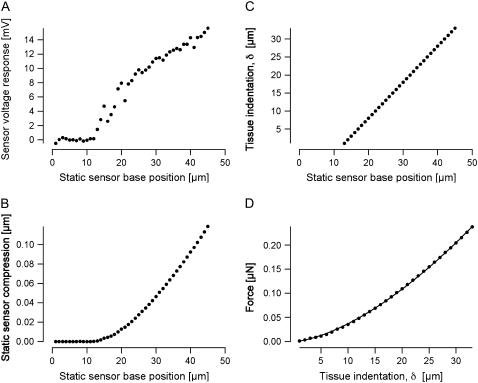FIGURE 3.
Measurement series obtained from a middle-turn location. (A) Responses at 10 Hz voltage recorded from the sensor as it was dynamically driven at static advancements onto the tissue. (B) Static compression of the sensor as it was advanced onto the tissue. The compression was calculated by an iterative method, as described in the text. Note that the abscissa is referenced to the starting position of the measurement series, when the sensor tip was in the fluid away from the tissue. For this particular measurement series, the sensor tip first contacted the tissue when the sensor base reached a position near 14 μm. (C) Tissue indentation δ as a function of position of the sensor base. Indentation is equivalent to the position of the sensor tip (relative to initial contact with the tissue) and is computed simply as the difference between the sensor base position (relative to initial contact) and the sensor compression. Note that, because of the relatively small internal compression of the sensor itself, the tissue indentation is almost equal to the displacement of the sensor base. (D) Applied force as a function of tissue indentation. The force was calculated from the static compression of the sensor in conjunction with the known input stiffness of the sensor. The solid circles show the values derived from the measurements, and the solid line is the result of fitting the modified Hertz model, as described in Methods.

